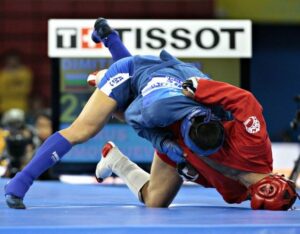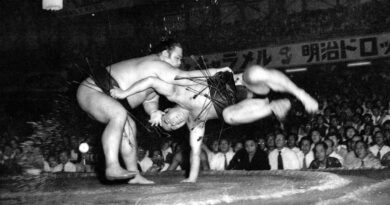What is Sambo, and what are its origins and history?
Table of Contents
-
- Introduction
- The History of Sambo: How the Martial Art Evolved from its Russian Roots
- The Rules and Regulations of Sambo: What You Need to Know Before You Start
- Exploring the Different Styles of Sambo: From Combat Sambo to Sport Sambo
- The Benefits of Sambo Training for Self-Defense and Fitness
- Tournaments and Ranking in Sambo
- Conclusion
Introduction
Sambo is a martial art that originated in Russia in the early 20th century. It is a combination of judo, wrestling, and other martial arts. Sambo is a full-contact sport that emphasizes throws, holds, and submission techniques. It is a popular sport in Russia and other former Soviet countries, and is gaining popularity in other parts of the world. Sambo is a great way to learn self-defense, improve physical fitness, and develop mental discipline.
The History of Sambo: How the Martial Art Evolved from its Russian Roots
The origins of Sambo can be traced back to the 1920s, when the Soviet Union was formed. At the time, the Soviet Union was looking for a way to improve the physical fitness of its citizens. To this end, the Soviet Union created a martial art called Samoz, which was a combination of judo, wrestling, and other martial arts.
The name Sambo was derived from the acronym SAMoz, which stands for Samozashchita Bez Oruzhiya, which translates to “self-defense without weapons.” The name was chosen to reflect the fact that Sambo was a martial art that focused on unarmed combat.
In the 1930s, the Soviet Union began to promote Sambo as a national sport. It was taught in schools and clubs, and it quickly gained popularity. By the 1950s, Sambo had become a popular sport in the Soviet Union, and it was even featured in the 1952 Olympics.
Since then, Sambo has spread around the world. It is now practiced in many countries, including the United States, Canada, and Japan. It is also a popular sport in Russia, where it is still taught in schools and clubs.
Sambo is a martial art that emphasizes grappling and ground fighting. It is a fast-paced and dynamic martial art that focuses on using leverage and technique to defeat an opponent. It is also known for its throws and submissions, which can be used to quickly end a fight.
Sambo is a martial art that has evolved over the years. It has been adapted to fit the needs of different countries and cultures, and it continues to evolve as it is practiced around the world. It is a martial art that has stood the test of time, and it is still popular today.
The Rules and Regulations of Sambo: What You Need to Know Before You Start
First, it is important to note that Sambo is a sport that is divided into two categories: sport Sambo and combat Sambo. Sport Sambo is a form of Sambo that is practiced in a competitive setting and is governed by the International Sambo Federation (FIAS). Combat Sambo is a form of Sambo that is practiced for self-defense and is governed by the All-Russian Sambo Federation (VFSS).
In both sport and combat Sambo, the rules and regulations are similar. All competitors must wear protective gear, such as a judo gi, headgear, and shin guards. All techniques must be performed with control and respect for the opponent. No strikes to the head or neck are allowed.
In sport Sambo, the match is divided into three rounds. The first round is a standing round, where competitors attempt to throw their opponents to the ground. The second round is a ground round, where competitors attempt to submit their opponents with holds and locks. The third round is a submission round, where competitors attempt to submit their opponents with holds and locks.
In combat Sambo, the match is divided into two rounds. The first round is a standing round, where competitors attempt to throw their opponents to the ground. The second round is a ground round, where competitors attempt to submit their opponents with holds and locks.
In both sport and combat Sambo, the winner is determined by the number of points scored. Points are awarded for throws, holds, and submissions. If the match ends in a draw, the winner is determined by the number of points scored in the last round.
It is important to note that Sambo is a sport that requires discipline and respect. All competitors must adhere to the rules and regulations of the sport. Failure to do so can result in disqualification or suspension from the sport.
By understanding the rules and regulations of Sambo, you can ensure that you have a safe and enjoyable experience while practicing the sport.
Exploring the Different Styles of Sambo: From Combat Sambo to Sport Sambo
Combat Sambo is the original form of Sambo, and is used for self-defense and combat. It is a full-contact martial art, and practitioners use a variety of techniques such as throws, joint locks, chokes, and strikes. Combat Sambo is designed to be effective in real-world situations, and practitioners must be prepared to defend themselves against multiple opponents.
Sport Sambo is a modified version of Combat Sambo, and is used in competition. It is a grappling-based martial art, and practitioners use throws, holds, and submission techniques to score points.
Both Combat Sambo and Sport Sambo have their own unique techniques and strategies, and practitioners must be familiar with both styles in order to be successful. Combat Sambo is more focused on self-defense and combat, while Sport Sambo is more focused on competition and scoring points.
No matter which style of Sambo you choose to practice, it is important to remember that it is a martial art that requires dedication and hard work. Practitioners must be willing to put in the time and effort to learn the techniques and strategies of both Combat Sambo and Sport Sambo in order to be successful.
The Benefits of Sambo Training for Self-Defense and Fitness
Sambo is designed to be a practical form of self-defense that can be used in a variety of situations. It is a highly effective form of self-defense that can be used to defend against strikes, throws, and submissions. Additionally, Sambo training teaches practitioners how to use their body weight and leverage to their advantage in a fight.
Sambo training is also a great way to get in shape and improve overall fitness. Sambo is a full-body workout that can help improve strength, flexibility, and endurance. It is a great way to burn calories and build muscle. Additionally, Sambo training can help improve coordination and balance, which can help improve overall athleticism.
Sambo training is a great way to get in shape. It is a highly effective form of self-defense that can be used in a variety of situations. Additionally, Sambo training provides a great workout and can help improve overall fitness. For those looking to improve their self-defense skills and get in shape, Sambo training is an excellent option.
Tournaments and Ranking in Sambo
Tournaments in Sambo are held at various levels, from local to international. Local tournaments are usually organized by clubs or associations, while international tournaments are organized by the International Sambo Federation (FIAS). The FIAS organizes the World Sambo Championships, which are held every two years. The World Championships are the highest level of competition in Sambo and attract the best athletes from around the world.
In Sambo, athletes are ranked according to their performance in tournaments. The FIAS maintains a ranking system for athletes based on their results in international tournaments. The rankings are updated after each tournament and are used to determine the seeding for future tournaments.
In addition to the FIAS rankings, some countries also have their own national rankings. These rankings are based on the results of national tournaments and are used to determine the seeding for national tournaments.
Sambo is a sport that is growing in popularity around the world. With its combination of judo, wrestling, and other martial arts, it is an exciting and challenging sport that is sure to continue to grow in popularity. Tournaments and rankings are an important part of the sport, as they provide a way for athletes to measure their progress and compete against the best in the world.
Conclusion
Sambo is an important figure in African American history, and his legacy continues to be remembered and celebrated today. He was a symbol of strength and resilience in the face of adversity, and his story serves as an inspiration to many. Sambo’s legacy is one of courage, determination, and perseverance, and his story will continue to be told for generations to come.





